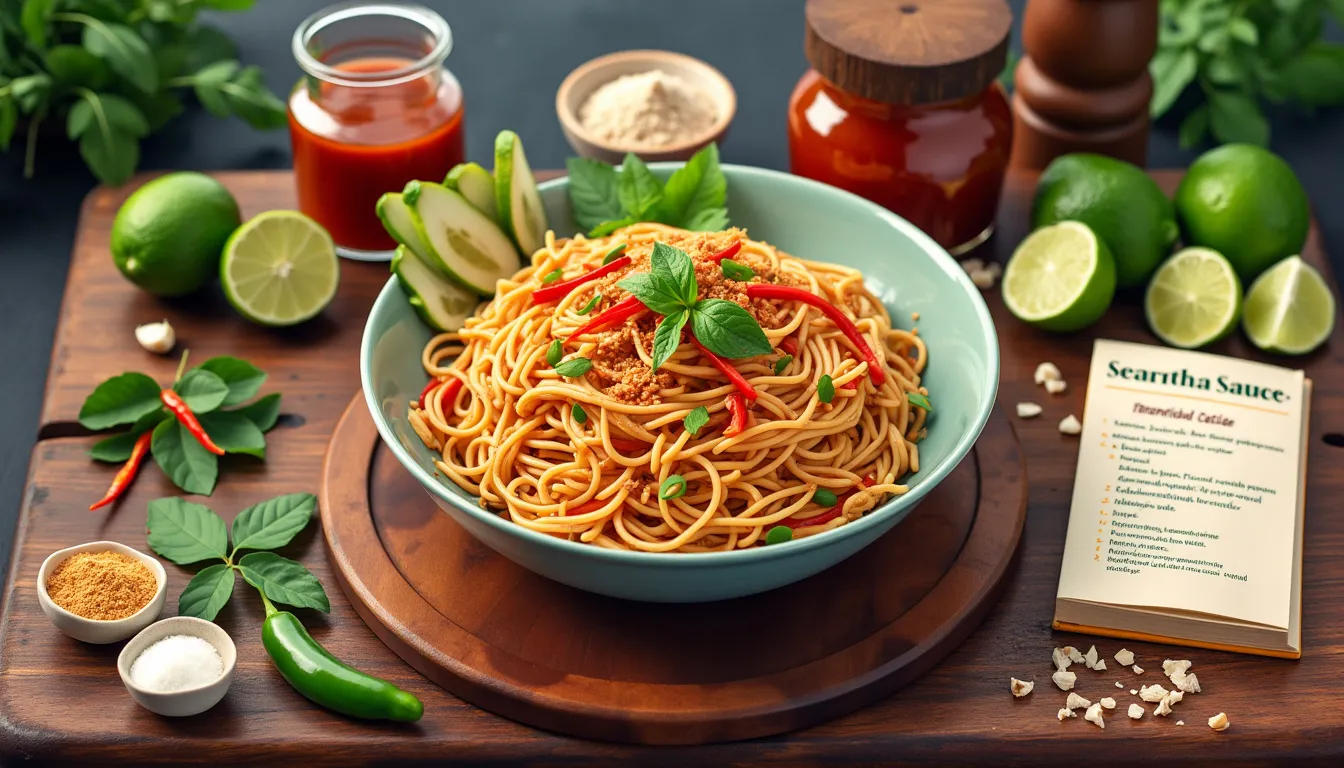Mastering the Perfect Pad Thai Sauce: A Flavorful Journey
When it comes to Thai cuisine, Pad Thai holds a special place in the hearts of food enthusiasts worldwide. Central to this beloved dish is the Pad Thai sauce—a harmonious blend of sweet, salty, sour, and spicy flavors that elevate the dish from ordinary to extraordinary. In this comprehensive guide, we embark on a flavorful journey to master the perfect Pad Thai sauce, ensuring that every ingredient, technique, and twist is explored for the ultimate culinary experience.
Understanding the Essential Ingredients for Authentic Pad Thai Sauce
Creating an authentic Pad Thai sauce begins with understanding its key components. The foundation of any great Pad Thai sauce is built on a trio of primary ingredients: tamarind paste, fish sauce, and palm sugar. These elements provide the essential balance that defines traditional Pad Thai.
Aromatics such as garlic, shallots, and chili peppers play a crucial role in adding depth and complexity to the sauce. Additionally, certain optional add-ins like soy sauce, lime juice, and even peanut butter can enhance the sauce, providing extra layers of flavor and richness.
Understanding the Essential Ingredients for Authentic Pad Thai Sauce
Creating the perfect Pad Thai sauce is both an art and a science, balancing flavors to achieve the iconic taste of this celebrated Thai dish. Mastering the sauce begins with a deep understanding of its essential ingredients and core components. When combined correctly, these elements bring about a symphony of sweet, sour, salty, and spicy notes. Let’s dive into what makes an authentic Pad Thai sauce truly stand out.
Key Primary Components: Tamarind Paste, Fish Sauce, and Palm Sugar
At the heart of traditional Pad Thai sauce are three key primary ingredients: tamarind paste, fish sauce, and palm sugar. Each of these components contributes a unique profile that defines the sauce’s authentic taste.
Tamarind paste is crucial for adding the sour tang that sets Pad Thai apart from other noodle dishes. Tamarind, derived from the tamarind tree, provides a rich, deep flavor that perfectly balances the sweetness and saltiness of the other ingredients. When selecting tamarind paste, look for pure, additive-free options to ensure the most authentic taste.
Fish sauce brings the salty, umami-rich backbone necessary for the sauce. Made from fermented fish, this liquid may seem pungent on its own, but when melded with the other ingredients, it enhances the overall depth of flavor. Quality fish sauce is typically darker and more aromatic, signaling a more concentrated and authentic product.
Palm sugar offers the sweetness that harmonizes the tang and saltiness. Unlike regular white sugar, palm sugar adds a caramel-like depth with nutty undertones, which is essential for an authentic Pad Thai experience. It’s derived from the sap of palm trees, and its natural, unrefined characteristics make it a preferred choice in traditional Thai cooking.
The Role of Aromatics: Garlic, Shallots, and Chili Peppers
No Pad Thai sauce is complete without the inclusion of aromatics, which infuse the sauce with layers of complexity and enhance its overall flavor profile.
Garlic is a staple in many Asian cuisines and is indispensable in Pad Thai sauce. Its pungent, slightly sweet flavor is released when chopped and sautéed, providing a robust base for the sauce.
Shallots add a subtle sweetness and a mild onion-like flavor. When cooked down, they become tender and help to thicken the sauce while adding a nuanced depth to the overall flavor. The combination of garlic and shallots creates a savory foundation that is both aromatic and inviting.
Chili peppers are the element that brings heat to the sauce. Depending on your spice tolerance, you can adjust the amount of chili to suit your preference. Fresh Thai bird’s eye chilies are commonly used for their intense heat and vibrant flavor. For a milder version, consider using red pepper flakes or a small amount of chili paste instead.
Optional Add-Ins for Extra Depth: Soy Sauce, Lime Juice, and Peanut Butter
While the primary and aromatic ingredients lay the groundwork for an authentic Pad Thai sauce, certain optional add-ins can elevate the sauce to new heights, adding extra layers of complexity and customization.
Soy sauce can be used in addition to fish sauce to enhance the umami flavor. Opt for a high-quality dark soy sauce for a richer, more robust flavor. This can also be an excellent alternative for those seeking a vegetarian or vegan option.
Lime juice introduces a fresh, zesty element that cuts through the richness of the sauce. A squeeze of lime can brighten up the dish, adding an extra layer of tanginess. Freshly squeezed lime juice is always best to capture its full, vibrant flavor.
Peanut butter might not be traditional, but it can add a creamy texture and a nutty depth that pairs wonderfully with the other ingredients. A small spoonful of natural, unsweetened peanut butter can transform the sauce into something profoundly rich and satisfying.
Understanding these essential ingredients and their roles in creating an authentic Pad Thai sauce is the first step in mastering this delicious flavor journey. Each component, from the tangy tamarind to the aromatic garlic and the optional add-ins, contributes to the symphony of flavors that make Pad Thai a beloved dish globally.
Step-by-Step Guide to Crafting The Perfect Pad Thai Sauce at Home
Preparing Your Ingredients: Tips for Choosing and Prepping Each Element
Creating an authentic pad thai sauce at home starts with selecting and preparing the right ingredients. The primary trio essential for a flavorful sauce includes tamarind paste, fish sauce, and palm sugar.
Tamarind Paste: This tangy, slightly sweet ingredient forms the backbone of pad thai sauce. When selecting tamarind paste, look for a concentrated variety free from added sugars or preservatives. To prepare, soak a tablespoon of tamarind pulp in a quarter cup of warm water for 15 minutes, then strain out the solids to obtain a rich tamarind liquid.
Fish Sauce: Adding umami depth, fish sauce is indispensable. Choose a reputable brand to ensure a clean, robust flavor. Pour about three tablespoons of fish sauce into a small bowl for easy mixing later.
Palm Sugar: Providing a subtle sweetness, palm sugar can be purchased in solid or syrup form. If you have solid palm sugar, grate or chop about three tablespoons into smaller pieces to help it dissolve more readily in the cooking process.
Aromatics and Optional Add-Ins: Aromatics like garlic, shallots, and chili peppers amplify the sauce’s complexity. Mince two cloves of garlic, finely chop one small shallot, and deseed and slice a red chili pepper. Optional add-ins, such as a tablespoon of soy sauce, a squeeze of fresh lime juice, or a dollop of peanut butter, can be prepared according to your desired flavor profile.
The Cooking Process: Balancing Flavors through Careful Mixing and Heating
Cooking the pad thai sauce is a delicate dance of balancing sweet, salty, and sour elements. Begin by heating a saucepan over medium heat and adding a small amount of vegetable oil. Once the oil is shimmering, add the minced garlic, chopped shallot, and sliced chili pepper, and sauté until fragrant and golden.
Next, pour in the tamarind liquid, fish sauce, and palm sugar. Stir the mixture continuously to ensure the palm sugar dissolves completely, creating a cohesive blend. Allow the mixture to simmer gently, stirring occasionally. This step is crucial as the heat helps meld together the flavors, enhancing the depth and richness of the sauce.
If you choose to incorporate optional add-ins, now is the time. Add the soy sauce, lime juice, and peanut butter, stirring thoroughly to combine. Taste the sauce and adjust the balance by adding more fish sauce for saltiness, tamarind paste for tanginess, or palm sugar for sweetness.
Continue to simmer the sauce for another 5-10 minutes, allowing it to thicken to a syrupy consistency. This ensures that when added to your noodles and other pad thai components, the sauce will coat them beautifully, resulting in a dish that bursts with flavor.
Storage and Preservation: Keeping Your Sauce Fresh for Future Use
Once you’ve perfected your pad thai sauce, you might find yourself wanting to keep some on hand for future meals. Proper storage is key to maintaining its flavor and freshness.
Allow the sauce to cool completely before transferring it to an airtight container. Refrigerate it and use within one week for the best taste. For longer storage, consider portioning the sauce into ice cube trays and freezing it. Once frozen, transfer the sauce cubes to a resealable plastic bag or a freezer-safe container. This method allows you to easily thaw and use just the right amount of sauce as needed.
Before using frozen sauce, thaw it in the refrigerator overnight or defrost it gently in a microwave. Give it a quick stir to re-incorporate any separated ingredients, and you’ll find it ready to elevate your next pad thai dish, bringing the same delicious complexity as when it was freshly made.
Elevating Your Pad Thai: Creative Twists on the Classic Sauce
Pad Thai, a globally cherished dish, owes its irresistible flavor to its sauce. While the traditional pad thai sauce is a carefully balanced mix of tamarind paste, fish sauce, and palm sugar, there’s ample room for creativity. Whether you prefer vegan and gluten-free options, love exploring regional flavors, or wish to enhance the dish with thoughtful toppings, here are some ingenious ways to elevate your pad thai sauce.
Vegan and Gluten-Free Variations: Substitutes and Adjustments
For those adhering to a vegan or gluten-free diet, simple tweaks can create a delightful pad thai sauce without compromising on flavor.
Vegan Substitutes:
Traditional pad thai sauce includes fish sauce, which is a no-go for vegans. Thankfully, several vegan alternatives can replicate the umami taste. One popular substitute is soy sauce, but to get closer to the fish sauce essence, you might prefer:
- Mushroom Soy Sauce: This rich, savory sauce is often used in Thai cuisine and provides a deeper flavor profile.
- Seaweed Salt: Incorporating finely ground seaweed can introduce the briny depth typically offered by fish sauce.
- Vegan Fish Sauce: Readily available in markets, these are crafted from ingredients like soy, seaweed, and mushrooms.
Gluten-Free Options:
To keep the sauce gluten-free, consider replacing any wheat-based soy sauce with tamari or coconut aminos:
- Tamari: A gluten-free soy sauce variant that’s slightly thicker but maintains a rich, savory taste.
- Coconut Aminos: This soy-free sauce is derived from coconut sap and offers a mild, slightly sweet flavor.
Regional Flavors: Integrating Local Ingredients for a Unique Spin
Infusing your pad thai sauce with regional flavors can transform your dish into a fusion masterpiece. Depending on your locality or taste preferences, consider these intriguing additions:
Miso Paste:
For a Japanese twist, incorporate a teaspoon of miso paste. This fermented soybean paste introduces a depth of umami and a hint of sweetness that blends seamlessly with the traditional ingredients.
Indian Curry Paste:
Introduce a spoonful of your favorite Indian curry paste for a hint of spice and complexity. Ingredients like coriander, cumin, and turmeric can bring an exciting dimension to your pad thai sauce.
Korean Gochujang:
To give your sauce a fiery kick and a bit of sweetness, mix in a small amount of gochujang, a Korean fermented chili paste. It complements the tamarind’s tanginess beautifully.
Enhancing the Sauce: Pairing with Toppings and Garnishes
The right toppings and garnishes can elevate your pad thai from delightful to unforgettable. These enhancements not only add texture but also introduce new flavors that harmonize with the sauce.
Fresh Herbs:
Add a handful of freshly chopped cilantro or Thai basil to your finished dish. These herbs lend a burst of freshness and a subtle anise note that balances the sweet and savory elements of the sauce.
Crushed Peanuts:
Sprinkle crushed roasted peanuts over your pad thai to add a satisfying crunch and earthy flavor that complements the sweetness of the palm sugar and the tang of the tamarind.
Lime Wedges:
Serving lime wedges on the side allows diners to squeeze fresh juice over their dish, enhancing the bright and tangy notes of the sauce.
Pickled Vegetables:
For added texture and a touch of acidity, garnish your pad thai with pickled vegetables such as pickled radishes or carrots. The acidity cuts through the richness of the sauce and balances the overall flavor.
Fried Shallots:
Crisp up thin slices of shallots and use them as a topping for an additional layer of flavor and a crunchy texture that contrasts with the noodles.
Conclusion
Mastering the perfect pad thai sauce opens a world of culinary possibilities. By exploring vegan and gluten-free substitutes, integrating regional flavors, and enhancing your dish with the right toppings and garnishes, you can create a pad thai experience that is uniquely your own. Whether you stick to the classic recipe or venture into creative variations, the key lies in balancing flavors and experimenting with confidence. With these tips, your pad thai sauce will not only captivate your taste buds but also elevate your cooking to an art form.
Conclusion: Bringing It All Together
Mastering the perfect Pad Thai sauce is more than just following a recipe; it’s about understanding and embracing the delicate balance of flavors that make this iconic dish so special. From the essential triad of tamarind paste, fish sauce, and palm sugar, to the aromatic undertones provided by garlic, shallots, and chili peppers, each ingredient plays a crucial role in crafting an authentic and tantalizing sauce.
By carefully preparing your ingredients and attentively balancing the flavors through cooking, you can recreate the magic of Pad Thai in your own kitchen. Whether you choose to keep things traditional or experiment with creative twists such as vegan, gluten-free variations, or regional adaptations, there is endless potential for personalization and innovation within the realm of Pad Thai sauce.
Remember, the journey does not end once the sauce is made. Proper storage ensures that your culinary efforts can be enjoyed multiple times, and pairing your Pad Thai with complementary toppings and garnishes can elevate the dish to new heights. As you continue to explore and experiment, your personal touch will shine through, allowing you to master the art of Pad Thai sauce and leave a lasting impression on anyone fortunate enough to taste your creation.
So, embark on this flavorful journey with confidence and creativity, and let your mastery of the perfect Pad Thai sauce inspire countless delicious meals. Happy cooking!







